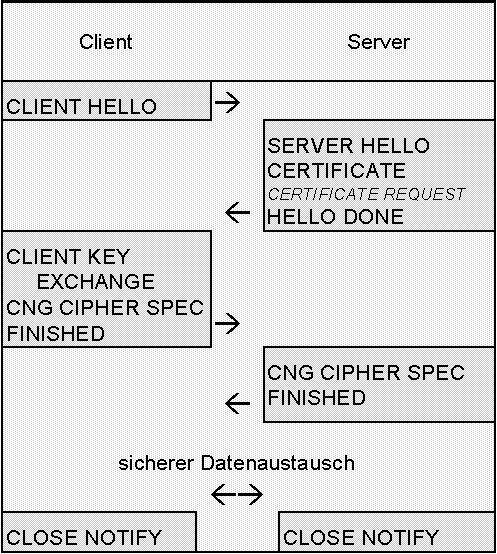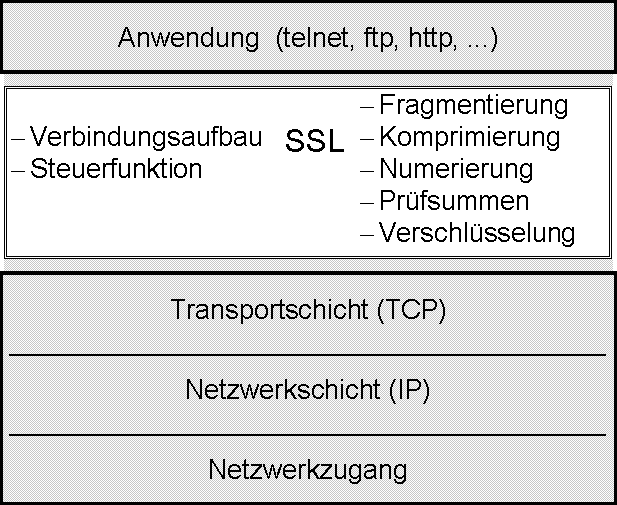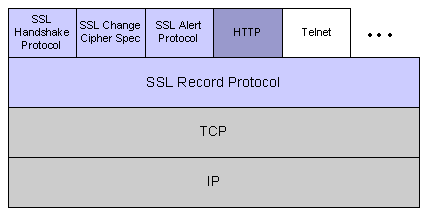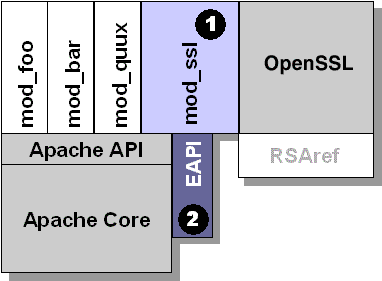Einführung Kryptographie
Transformation von Nachrichten (messages, plain text)
in verschlüsselte Nachrichten (cipher text) mit Hilfe
von Algorithmen / Programmen (cipher suites) und Schlüsseln (keys).
geheime Algorithmen (-> unpraktikabel)
Standard Versuch bei Banken und Telecoms
bekannte Algorithmen mit geheimen Schlüsseln
im internationalen Security Bereich
Kryptographische Basisalgorithmen
- Symmetrisch
-
gleicher Schlüssel für Ver- und
Entschlüsselung
sehr schnell
Problem: Anzahl der Schlüssel
Problem: Austausch der Schlüssel
Beispiele: DES, RC4, Triple-DES, RC2, Idea, Fortezza
(PINs, TANs)
- Asymmetrisch
-
unterschiedliche Schlüssel für Ver- und
Entschlüsselung
public und private key
relativ langsam
bei richtiger Wahl der Parameter sehr / beliebig sicher
Sicherheit basiert auf der Schwierigkeit der
Faktorisierung grosser Zahlen
Beispiele: RSA, DSA, DSS, Diffie-Hellman
Diffie-Hellman (exponential key exchange):
zum Aufbau von sicheren Verbindungen aus einem unsicheren Zustand
(allerdings ohne Authentifizierung)
- Message Digests
-
Prüfsummenbildung (Hash Verfahren)
Berechnung einer Zahl aus einer Nachricht
Zahl verändert sich, wenn Nachricht sich ändert
Beispiele: MD5, SHA, SHA1
Message Authentication Code (MAC)
Kryptographische Basistechniken
- Digitale Signatur, Digitale Unterschriften
-
basiert auf Digest (Hash) und asymmetrischer Verschlüsselung
Berechnung und Verschlüsselung der Prüfsumme
gewährleistet Authentizität
- Certification, Zertifizierung
-
benötigt unabhängige Verwalter: Certification Authority (CA),
sichert die Authentizität von Schlüsseln zu.
basiert auf asymmetrischer Verschlüsselung,
die CA codiert public keys von Teilnehmern mit ihrem private key
Server verschickt sein Zertifikat an Client
bzw. auch umgekehrt: Client verschickt sein Zertifikat an Server
Zertifikat bestätigt Echtheit des Servers
(Echtheit = Zuordnung Server zu public key)
public key der CA muß dem Client bekannt sein
- Blinde Unterschriften
-
löst Anonymitätsproblem bei digitalem Geld
Unterschrift durch Umschlag mit Kohlepapier
zB. Zertifizierung von eCash unter Wahrung der
Anonymität
Certificates, Zertifikate
Zertifikat verbindet einen public key mit der
Identifikation einer Person.
Die Personen-Identifikation erfolgt mit einem
Distinguished Name (DN).
Die Spezifikation eines DN ist im X.509 Standard festgelegt.
| DN Feld |
Abkürzung |
Bedeutung |
| Common Name |
CN |
Name der Person |
| Organization |
O |
Firma oder Organisation |
| Organizational Unit |
OU |
Abteilung oder Firmenteil |
| Locality |
L |
Stadt, Sitz der Organisation |
| State |
ST |
Staat, Provinz, Gegend |
| Country |
C |
ISO Länderkode |
Beispiel:
CN=Karl Dall
O=Schlangenöl AG
OU=Brillenabteilung
L=Schlangenbad
ST=Hessen
C=de
Ein Zertifikat kombiniert die Informationen über das
Individuum mit Informationen über die Ausgabestelle und
diversen Verwaltungsinformationen:
- Subject: Individuum
- Distinguished Name, Public Key
- Issuer: Ausgabestelle
- Distinguished Name, Signature
- Period of Validity: Geltungsdauer
- Not Before Date, Not After Date
- Administrative Infos:
- Certificate Version, Serial Number
- Extended Infos: Zusatzinformationen
- Basic Constraints, Netscape Flags, etc.
Certificate:
Data:
Version: 3 (0x2)
Serial Number: 1 (0x1)
Signature Algorithm: md5WithRSAEncryption
Issuer: C=XY, ST=Snake Desert, L=Snake Town, O=Snake Oil, Ltd,
OU=Certificate Authority, CN=Snake Oil CA/Email=ca@snakeoil.dom
Validity
Not Before: Oct 29 17:39:10 2000 GMT
Not After : Oct 29 17:39:10 2001 GMT
Subject: C=DE, ST=Germany, L=Weinheim, O=Home, OU=Web Lab,
CN=kredel-wh.isdn.uni-mannheim.de/Email=kredel@rz.uni-mannheim.de
Subject Public Key Info:
Public Key Algorithm: rsaEncryption
RSA Public Key: (1024 bit)
Modulus (1024 bit):
00:c4:40:4c:6e:14:1b:61:36:84:24:b2:61:c0:b5:
...
f0:b4:95:f5:f9:34:9f:f8:43
Exponent: 65537 (0x10001)
X509v3 extensions:
X509v3 Subject Alternative Name:
email:kredel@rz.uni-mannheim.de
Netscape Comment:
mod_ssl generated test server certificate
Netscape Cert Type:
SSL Server
Signature Algorithm: md5WithRSAEncryption
12:ed:f7:b3:5e:a0:93:3f:a0:1d:60:cb:47:19:7d:15:59:9b:
...
Zertifikate können bei verschiedenen Organisationen (gegen Gebühr)
bestellt werden.
Zum Beispiel bei Verisign, Thawte, CertiSign oder IKS GmbH.
Kryptographie und TCP/IP
Einsatzpunkte im Schichtenmodell
| Schicht |
Bemerkungen |
Kryptographie |
5. Verarbeitung
Anwendung |
Telnet, FTP, SMTP, NNTP, HTTP |
S-HTTP,
HTTP over SSL |
| 4. Transport |
TCP, UDP |
SSL |
| 3. Vermittlung |
IP, Internet Protocoll |
IPv6 |
| 2. Sicherung |
Adapter-Karten |
|
| 1. Bitübertragung |
Leitungen, Elektronik |
|
Verarbeitungs- / Anwendungsebene
Transportschicht
einmalige Implementierung
alle Daten werden verschlüsselt
Beispiel: Secure Socket Layer (SSL)
HTTP over SSL: https://host/path/x.html
Netzwerkschicht / Vermittlungsebene
einmalige Implementierung
alle Daten werden verschlüsselt
Beispiel: IP version 6 (IPv6)
S-HTTP
Secure Hypertext Transfer Protocol
- Vorteile
flexibel, sehr viele Verfahren unterstützt
keine Probleme mit Firewalls
erweiterbar ohne Rücksicht auf TCP/IP
- Nachteile
nur für HTTP anwendbar
benötigt spezielle Browser Unterstützung
Secure Socket Layer (SSL)
implementiert die TCP/IP Socket Programmier-Schnittstelle
Protokoll zur sicheren Client/Server Datenübertragung
Standardisiert:
SSL 2.0 (von Netscape),
SSL 3.0 (Internet Draft von Netscape),
TLS 1.0 (Proposed Internet Standard, von IETF)
Ziele
kryptographische Sicherheit
Interoperabilität
offenes Protokoll
Erweiterbarkeit
neue Verfahren können eingebunden werden
Effizienz
Speichermöglichkeit für ausgehandelte
Verbindungen
- Vorteile
für alle TCP/IP Anwendungen nutzbar
leichter zu benutzen und zu verwalten
effizient
- Nachteile
evtl. Probleme mit Firewalls
erweiterbar nur mit Rücksicht auf TCP/IP
SSL in TCP/IP
SSL Protokoll liegt zwischen der Transportschicht und der
Anwendungsschicht
SSL - Aufbau
SSL besteht aus zwei Schichten plus Statusinformationen
Steuerprotokolle
Verbindungsaushandlung
schreibt Verbindungsparameter in Status
austauschbar
Handshake Protocol, Change Cipher Protocol, Alert Protocol
Recordprotokoll
Status
SSL - Sessions

Ablauf einer Verbindung
SSL - Verbindungsaufbau
durch SSL Handshake Protokoll
Aushandeln von Verbindungsmodalitäten
Protocol Version, Session Id, Cipher Suite,
Compression Method, Random Variables
Austausch von Zertifikaten
(optional)
Schlüsselaustausch
(optional)
Umstellen der Verbindung entsprechend den ausgehandelten Werten
SSL - Cipher Suites
Key Exchange Method
wie werden die gemeinsamen symmetrischen Schlüssel ausgetauscht ?
SSL 2.0 nur RSA, SSL 3.0 auch andere
Cipher for Data Transfer, mit symmetrischen Schlüssel
Stream Ciphers: RC4
Block Ciphers: RC2, DES, Triple-DES, IDEA
Message Digest Method
MD5, SHA-1, für Message Authentication (MAC)
SSL - Fehlerbehandlung
SSL Alert Protokoll behandelt folgende Fehlerarten
=> Fehlerfall: Nachricht und Verbindungsabbruch
SSL - Implementierungen
Browser:
Netscape 1.x, 2.x, 3.x, 4.x, 6.x
Microsoft IE 3.x, 4.x, 5.x
Lynx 2.8 mit OpenSSL
Server:
Netscape, Microsoft
Apache mit mod_ssl und OpenSSL
Probleme:
Import / Export Restriktionen einzelner Länder
Beschränkungen in der Schlüssellänge
Patentierung einiger Verfahren
Apache mod_ssl
mod_ssl wurde von von Ralf S. Engelschall im April 1998 entwickelt.
Weiterentwicklung des Apache-SSL Packets von Ben Laurie.
Verwendet OpenSSL von Eric A. Young and Tim Hudson.
Implementiert den https: Dienst.
Default Port ist 443.
Konfiguration
für Apache, mod_ssl, OpenSSL der SuSE Linux Distribution
Sicherstellen, dass alle benötigten Teile installiert sind
Apache, mod_ssl, OpenSSL
Erzeugen eines Zertifikats
cd /usr/share/doc/packages/mod_ssl
./certificate.sh
siehe Beispiel
Aktivieren von mod_ssl in der Apache Konfiguration
in conf/httpd.conf
SSLEngine on
und einstellen der weiteren erforderlichen Parameter,
siehe Beispiel
Apache restarten
Log Files überwachen
SSL Zugriff auf beliebige Seiten mit
https://host/path/x.html
Erzeugen eines Zertifikats
Kryptographischen Algorithmus auswählen
entsprechenden Schlüssel erzeugen
Distinguished Name festlegen
damit kann eine Zertifikatanforderung generiert werden
erzeugen eines Spiel-Zertifikats
schützen des generierten Schlüssels durch Pass-Phrase
localhost:/usr/share/doc/packages/mod_ssl # ./certificate.sh
SSL Certificate Generation Utility (mkcert.sh)
Copyright (c) 1998 Ralf S. Engelschall, All Rights Reserved.
Generating test certificate signed by Snake Oil CA [TEST]
WARNING: Do not use this for real-life/production systems
______________________________________________________________________
STEP 0: Decide the signature algorithm used for certificate
The generated X.509 CA certificate can contain either
RSA or DSA based ingredients. Select the one you want to use.
Signature Algorithm ((R)SA or (D)SA) [R]:
______________________________________________________________________
STEP 1: Generating RSA private key (1024 bit) [server.key]
4139358 semi-random bytes loaded
Generating RSA private key, 1024 bit long modulus
........++++++
.++++++
e is 65537 (0x10001)
______________________________________________________________________
STEP 2: Generating X.509 certificate signing request [server.csr]
Using configuration from .mkcert.cfg
You are about to be asked to enter information that will be incorporated
into your certificate request.
What you are about to enter is what is called a Distinguished Name or a DN.
There are quite a few fields but you can leave some blank
For some fields there will be a default value,
If you enter '.', the field will be left blank.
-----
1. Country Name (2 letter code) [XY]:DE
2. State or Province Name (full name) [Snake Desert]:Germany
3. Locality Name (eg, city) [Snake Town]:Weinheim
4. Organization Name (eg, company) [Snake Oil, Ltd]:Home
5. Organizational Unit Name (eg, section) [Webserver Team]:Web Lab
6. Common Name (eg, FQDN) [www.snakeoil.dom]:kredel-wh.uni-mannheim.de
7. Email Address (eg, name@FQDN) [www@snakeoil.dom]:kredel@rz.uni-mannheim.de
______________________________________________________________________
STEP 3: Generating X.509 certificate signed by Snake Oil CA [server.crt]
Certificate Version (1 or 3) [3]:
Signature ok
subject=/C=DE/ST=Germany/L=Weinheim/O=Home/OU=Web Lab/CN=kredel-wh.uni-mannheim.de/Email=kredel@rz.uni-mannheim.de
Getting CA Private Key
Verify: matching certificate & key modulus
read RSA key
Verify: matching certificate signature
/etc/httpd/ssl.crt/server.crt: OK
______________________________________________________________________
STEP 4: Enrypting RSA private key with a pass phrase for security [server.key]
The contents of the server.key file (the generated private key) has to be
kept secret. So we strongly recommend you to encrypt the server.key file
with a Triple-DES cipher and a Pass Phrase.
Encrypt the private key now? [Y/n]: n
Warning, you're using an unencrypted RSA private key.
Please notice this fact and do this on your own risk.
______________________________________________________________________
RESULT: Server Certification Files
o conf/ssl.key/server.key
The PEM-encoded RSA private key file which you configure
with the 'SSLCertificateKeyFile' directive (automatically done
when you install via APACI). KEEP THIS FILE PRIVATE!
o conf/ssl.crt/server.crt
The PEM-encoded X.509 certificate file which you configure
with the 'SSLCertificateFile' directive (automatically done
when you install via APACI).
o conf/ssl.csr/server.csr
The PEM-encoded X.509 certificate signing request file which
you can send to an official Certificate Authority (CA) in order
to request a real server certificate (signed by this CA instead
of our demonstration-only Snake Oil CA) which later can replace
the conf/ssl.crt/server.crt file.
WARNING: Do not use this for real-life/production systems
Beispiel Schlüssel und Zertifikate
Die Schlüssel und Zertifikate kann man sich mit
einem Tool aus OpenSSL anzeigen lassen.
openssl rsa -noout -text -in conf/ssl.key/server.key
openssl x509 -noout -text -in conf/ssl.crt/server.crt
openssl req -noout -text -in conf/ssl.csr/server.csr
openssl s_client -connect localhost:443 -state -debug
Der Parameter
rsa zeigt einen RSA Schlüssel,
x509 zeigt ein Zertifikat und
req zeigt eine Zertifikatanforderung an.
Private Key des Servers: conf/ssl.key/server.key
-----BEGIN RSA PRIVATE KEY-----
MIICXAIBAAKBgQDEQExuFBthNoQksmHAtdfkeqVLlO/ZXkN/wWSA/Z9QQWtwc4BI
kPNYv/BMuZAygVkYFj8Z9F8RaDaF9hyprxqpqHtEhXm18SDTJX0c3mgVDLa8WUYK
2JlOB1AKXYNh1NvJfcMu6wqPYo9+AOE3Zz821QQ4RER36fC0lfX5NJ/4QwIDAQAB
AoGARVmPaKrUThMMuUcMAiSASS4J8V6NL1v/MEsv7+EwBhVIGTHHmF0YkTkqeoJs
cVyCFl/uJobTfXw9IDOrR08odUMvuHMdFOdC4n80HMk4WC3l7LuXIFL+ircZ3EFe
6kFc8WNFT2d-lnhIG3aqRKApP6Mkc+ZoL0EtN/m0WsICYlECQQDlCa7+sFRlX56j
jokOWmN595ouqn1tFIW/em4gSlj7s8Blsij8dPOen3NHGjPZwbon6EdmaZhaVoco
E5elwgGbAkEA21qNMZC6oF9vW7B53YE5z7KDi/CXiHh7gNsRKn7SnTr5S6MHOjol
3VsDsqaIsY+S2KONFWOxTpPJW6nj014CeQJAdiJfg3hZn4wJXB0priCLDJ7chNNl
LD0Ym2G/qaIPcYwOYaXaJBUCjz95CySFt/yHUwwov7cZYQceYVpxrop5nwJAQyQo
a699MHGFyG7wHljbtTNTCJaQC3m1c++aBYPkO7Q9cmVoZO4/gM3HB/vpg1ALBryp
Bo8JSp/51lDeJ2hzIQJBAKu15hbskAfQVCXK21ShoojHsg03W6G58j+O0OgR8x+E
QTDemBaP2ARbGqvFbe+px6nUy0COS6+CGmNvYAaIr74=
-----END RSA PRIVATE KEY-----
openssl rsa -noout -text -in conf/ssl.key/server.key
read RSA key
Private-Key: (1024 bit)
modulus:
00:c4:40:4c:6e:14:1b:61:36:84:24:b2:61:c0:b5:
d7:e4:7a:a5:4b:94:ef:d9:5e:43:7f:c1:64:80:fd:
9f:50:41:6b:70:73:80:48:90:f3:58:bf:f0:4c:b9:
90:32:81:59:18:16:3f:19:f4:5f:11:68:36:85:f6:
1c:a9:af:1a:a9:a8:7b:44:85:79:b5:f1:20:d3:25:
7d:1c:de:68:15:0c:b6:bc:59:46:0a:d8:99:4e:07:
50:0a:5d:34:61:d4:db:c9:7d:c3:2e:eb:0a:8f:62:
8f:7e:00:e1:37:67:3f:36:d5:04:38:44:44:77:e9:
f0:b4:95:f5:f9:34:9f:f8:43
publicExponent: 65537 (0x10001)
privateExponent:
45:59:8f:68:aa:d4:4e:13:0c:b9:47:0c:02:24:80:
49:2e:09:f1:5e:8d:2f:5b:ff:30:4b:2f:ef:e1:30:
06:15:48:19:31:c7:98:5d:18:91:39:2a:7a:82:6c:
71:5c:82:16:5f:ee:26:86:d3:7d:7c:3d:20:33:ab:
47:4f:28:75:93:2f:b8:73:1d:14:e7:42:e2:7f:34:
1c:c9:38:58:2d:e5:ec:bb:97:20:52:fe:8a:b7:19:
dc:41:5e:ea:41:5c:f1:63:45:4f:67:7e:96:78:48:
1b:76:aa:44:a0:29:3f:a3:24:73:e6:68:2f:41:2d:
37:f9:b4:5a:c2:02:62:51
prime1:
00:e5:09:ae:fe:b0:54:65:5f:9e:a3:8e:89:0e:5a:
63:79:f7:9a:2e:aa:7d:6d:14:85:bf:7a:6e:20:4a:
58:fb:b3:c0:66:b2:28:fc:74:f3:9e:9f:73:47:1a:
33:d9:c1:ba:27:e8:47:66:69:98:5a:56:87:28:13:
97:a5:c2:01:9b
prime2:
00:db:5a:8d:31:90:ba:a0:5f:6f:5b:b0:79:dd:81:
39:cf:b2:83:8b:f0:97:88:78:7b:80:db:11:2a:7e:
d2:9d:3a:f9:4b:f3:07:3a:3a:25:dd:5b:03:b2:a6:
88:b1:8f:92:d8:a3:8d:15:63:b1:4e:93:c9:5b:a9:
e3:d3:5e:02:79
exponent1:
76:22:5f:83:78:59:9f:8c:09:5c:1d:29:ae:20:8b:
0c:9e:dc:84:d3:65:2c:3d:18:9b:61:bf:a9:a2:0f:
71:8c:0e:61:a5:df:24:15:02:8f:3f:79:0b:24:85:
b7:fc:87:53:0c:28:bf:b7:19:61:07:1e:61:5a:71:
ae:8a:79:9f
exponent2:
43:24:28:6b:af:7d:30:71:85:c8:6e:f0:1e:58:db:
b5:33:53:08:96:90:0b:79:b5:73:ef:9a:05:83:e4:
3b:b4:3d:72:6a:68:64:ee:3f:80:cd:c7:07:fb:e9:
83:50:0b:06:bc:a9:06:8f:09:4a:9f:f9:d6:50:de:
27:68:73:21
coefficient:
00:ab:b5:e6:16:ec:90:07:d0:54:25:ca:db:54:a1:
a2:88:c7:b2:0d:37:5b:a1:b9:f2:3f:8e:d0:e8:11:
f3:1f:84:41:30:ee:98:16:8f:d8:04:5b:1a:ab:c5:
6d:ef:a9:c7:a9:d4:cb:40:8e:4b:af:82:1a:63:6f:
60:06:88:af:be
Server Zertifikat: conf/ssl.key/server.crt
-----BEGIN CERTIFICATE-----
MIIDQDCCAqmgAwIBAgIBATANBgkqhkiG9w0BAQQFADCBqTELMAkGA1UEBhMCWFkx
FTATBgNVBAgTDFNuYWtlIERlc2VydDETMBEGA1UEBxMKU25ha2UgVG93bjEXMBUG
A1UEChMOU25ha2UgT2lsLCBMdGQxHjAcBgNVBAsTFUNlcnRpZmljYXRlIEF1dGhv
cml0eTEVMBMGA1UEAxMMU25ha2UgT2lsIENBMR4wHAYJKoZIhvcNAQkBFg9jYUBz
bmFrZW9pbC5kb20wHhcNMDAxMDI5MTczOTEwWhcNMDExMDI5MTczOTEwWjCBqjEL
MAkGA1UEBhMCREUxEDAOBgNVBAgTB0dlcm1hbnkxETAPBgNVBAcTCFdlaW5oZWlt
MREwDwYDVQQKEwhIb21lIExhYjEQMA4GA1UECxMHV2ViIExhYjEnMCUGA1UEAxMe
a3JlZGVsLXdoLmlzZG4udW5pLW1hbm5oZWltLmRlMSgwJgYJKoZIhvcNAQkBFhlr
cmVkZWxAcnoudW5pLW1hbm5oZWltLmRlMIGfMA0GCSqGSIb3DQEBAQUAA4GNADCB
iQKBgQDEQExuFBthNoQksmHAtdfkeqVLlO/ZXkN/wWSA/Z9QQWtwc4BIkPNYv/BM
uZAygVkYFj8Z9F8RaDaF9hyprxqpqKtEhXm18SDTJX0c3mgVDLa8WUYK2JlOB1AK
XYNh1NvJfcMu6wqPYo9+AOE3Zz821QQ4RER36fC0lfX5NJ/4QwIDAQABo3UwczAk
BgNVHREEHTAbgRlrcmVkZWxAcnoudW5pLW1hbm5oZWltLmRlMDgGCWCGSAGG+EIB
DQQrFiltb2Rfc3NsIGdlbmVyYXRlZCB0ZXN0IHNlcnZlciBjZXJ0aWZpY2F0ZTAR
BglghkgBhvhCAQEEBAMCBkAwDQYJKoZIhvcNAQEEBQADgYEAEu33s16gkz+gHWDL
Rxl9FVmbOyyoo2oDQ9CF04aGL+OqeTnngiDt9BGFo0FeXI02onG2agj5zB7axHgF
dYmbEPAV8J5noE6hTT8WTJsZVmryr4lUUkoGNEIN1UAla7DAogMYzdEHILblxR4h
ROfFCdLVlJ1sEwcvO3xMZJC//44=
-----END CERTIFICATE-----
openssl x509 -noout -text -in conf/ssl.crt/server.crt
Certificate:
Data:
Version: 3 (0x2)
Serial Number: 1 (0x1)
Signature Algorithm: md5WithRSAEncryption
Issuer: C=XY, ST=Snake Desert, L=Snake Town, O=Snake Oil, Ltd, OU=Certificate Authority, CN=Snake Oil CA/Email=ca@snakeoil.dom
Validity
Not Before: Oct 29 17:39:10 2000 GMT
Not After : Oct 29 17:39:10 2001 GMT
Subject: C=DE, ST=Germany, L=Weinheim, O=Home, OU=Web Lab, CN=kredel-wh.isdn.uni-mannheim.de/Email=kredel@rz.uni-mannheim.de
Subject Public Key Info:
Public Key Algorithm: rsaEncryption
RSA Public Key: (1024 bit)
Modulus (1024 bit):
00:c4:40:4c:6e:14:1b:61:36:84:24:b2:61:c0:b5:
d7:e4:7a:a5:4b:94:ef:d9:5e:43:7f:c1:64:80:fd:
9f:50:41:6b:70:73:80:48:90:f3:58:bf:f0:4c:b9:
90:32:81:59:18:16:3f:19:f4:5f:11:68:36:85:f6:
1c:a9:af:fa:a9:a8:7b:44:85:79:b5:f1:20:d3:25:
7d:1c:de:68:15:0c:b6:bc:59:46:0a:d8:99:4e:07:
50:0a:5d:83:61:d4:db:c9:7d:c3:2e:eb:0a:8f:62:
8f:7e:00:e1:37:67:3f:36:d5:04:38:44:44:77:e9:
f0:b4:95:f5:f9:34:9f:f8:43
Exponent: 65537 (0x10001)
X509v3 extensions:
X509v3 Subject Alternative Name:
email:kredel@rz.uni-mannheim.de
Netscape Comment:
mod_ssl generated test server certificate
Netscape Cert Type:
SSL Server
Signature Algorithm: md5WithRSAEncryption
12:ed:f7:b3:5e:a0:93:3f:a0:1d:60:cb:47:19:7d:15:59:9b:
3b:2c:a8:a3:6a:03:43:d0:85:d3:86:86:2f:e3:aa:79:39:e7:
82:20:ed:f4:11:85:a3:41:5e:5c:8d:36:a2:71:b6:6a:08:f9:
cc:1e:da:c4:78:05:75:8f:9b:10:f0:15:f0:9e:67:a0:4e:a1:
4d:3f:16:4c:9b:19:56:6a:f2:af:89:54:52:4a:06:34:42:0d:
d5:40:25:6b:b0:c0:a2:03:18:cd:d1:07:20:b6:e5:c5:1e:21:
44:e7:c5:09:d2:d5:94:9d:6c:13:07:2f:3b:7c:4c:64:90:bf:
ff:8e
Zertifikatanforderung: conf/ssl.key/server.csr
-----BEGIN CERTIFICATE REQUEST-----
MIIB6zCCAVQCAQAwgaoxCzAJBgNVBAYTAkRFMRAwDgYDVQQIEwdHZXJtYW55MREw
DwYDVQQHEwhXZWluaGVpbTERMA8GA1UEChMISG9tZSBMYWIxEDAOBgNVBAsTB1dl
YiBMYWIxJzAlBgNVBAMTHmtyZWRlbC13aC5pc2RuLnVuaS1tYW5uaGVpbS5kZTEo
MCYGCSqGSIb3DQEJARYZa3JlZGVsQHJ6LnVuaS1tYW5uaGVpbS5kZTCBnzANBgkq
hkiG9w0BAQEFAAOBjQAwgYkCgYEAxEBMbhQbYTaEJLJhwLXX5HqlS5Tv2V5Df8Fk
gP2fUEFrcHOASJDzWL/wTLmQMoFZGBY+GfRfEWg2hfYcqa8aqah7RIV5tfEg0yV9
HN5oFQy2vFlGCtiZTgdQCl2DYdTbyX3DLusKj2KPfgDhN2c/NtUEOEREd+nwtJX1
+TSf+EMCAwEAAaAAMA0GCSqGSIb3DQEBBAUAA4GBACSVE7CQiBDJOJSGUhLwt9TA
lp14391PoSF+kszWdpr5q0v3ce95EMdf4uCiqPEWvNibNNpas6LBH2kjfaXRDbLR
sYrGLU45z/Arq+9vsNyC+c3NcXHKSAuHhfXoFieTVjZj7+DE0JCWIhf7KN9dxSwN
srHUPndOfSSiMk6eXbuL
-----END CERTIFICATE REQUEST-----
openssl req -noout -text -in conf/ssl.csr/server.csr
Using configuration from /usr/ssl/openssl.cnf
Certificate Request:
Data:
Version: 0 (0x0)
Subject: C=DE, ST=Germany, L=Weinheim, O=Home, OU=Web Lab, CN=kredel-wh.isdn.uni-mannheim.de/Email=kredel@rz.uni-mannheim.de
Subject Public Key Info:
Public Key Algorithm: rsaEncryption
RSA Public Key: (1024 bit)
Modulus (1024 bit):
00:c4:40:4c:6e:14:1b:61:36:84:24:b2:61:c0:b5:
d7:e4:7a:a5:4b:94:ef:d9:5e:43:7f:c1:64:80:fd:
9f:50:41:6b:70:73:80:48:90:f3:58:bf:f0:4c:b9:
90:32:81:59:18:16:3f:19:f4:5f:11:68:36:85:f6:
1c:a9:af:1a:f9:a8:7b:44:85:79:b5:f1:20:d3:25:
7d:1c:de:68:15:0c:b6:bc:59:46:0a:d8:99:4e:07:
50:0a:5d:83:61:d4:db:c9:7d:c3:2e:eb:0a:8f:62:
8f:7e:00:e1:3e:67:3f:36:d5:04:38:44:44:77:e9:
f0:b4:95:f5:f9:34:9f:f8:43
Exponent: 65537 (0x10001)
Attributes:
a0:00
Signature Algorithm: md5WithRSAEncryption
24:95:13:b0:90:88:10:c9:38:94:86:52:12:f0:b7:d4:c0:96:
9d:78:df:dd:4f:a1:21:7e:92:cc:d6:76:9a:f9:ab:4b:f7:71:
ef:79:10:c7:5f:e2:e0:a2:a8:f1:16:bc:d8:9b:34:da:5a:b3:
a2:c1:1f:69:23:7d:a5:d1:1d:b2:d1:b1:8a:c6:2d:4e:39:cf:
f0:2b:ab:ef:6f:b0:dc:82:f9:cd:cd:71:71:ca:48:0b:87:85:
f5:e8:16:27:93:56:36:63:ef:e0:c4:d0:90:96:22:17:fb:28:
df:5d:c5:2c:0d:b2:b1:d4:3e:77:4e:7d:24:a2:32:4e:9e:5d:
bb:8b
Apache Konfiguration
wesentlich SSLEngine on
<VirtualHost _default_:443>
# General setup for the virtual host
DocumentRoot "/usr/local/httpd/htdocs"
ServerName kredel-wh.isdn.uni-mannheim.de
ServerAdmin root@kredel-wh.isdn.uni-mannheim.de
ErrorLog /var/log/httpd/error_log
TransferLog /var/log/httpd/access_log
# SSL Engine Switch:
# Enable/Disable SSL for this virtual host.
#SSLEngine off
SSLEngine on
# SSL Cipher Suite:
# List the ciphers that the client is permitted to negotiate.
# See the mod_ssl documentation for a complete list.
SSLCipherSuite ALL:!ADH:!EXP56:RC4+RSA:+HIGH:+MEDIUM:+LOW:+SSLv2:+EXP:+eNULL
# Server Certificate:
# Point SSLCertificateFile at a PEM encoded certificate. If
# the certificate is encrypted, then you will be prompted for a
# pass phrase. Note that a kill -HUP will prompt again. A test
# certificate can be generated with `make certificate' under
# built time. Keep in mind that if you've both a RSA and a DSA
# certificate you can configure both in parallel (to also allow
# the use of DSA ciphers, etc.)
SSLCertificateFile /etc/httpd/ssl.crt/server.crt
#SSLCertificateFile /etc/httpd/ssl.crt/server-dsa.crt
# Server Private Key:
# If the key is not combined with the certificate, use this
# directive to point at the key file. Keep in mind that if
# you've both a RSA and a DSA private key you can configure
# both in parallel (to also allow the use of DSA ciphers, etc.)
SSLCertificateKeyFile /etc/httpd/ssl.key/server.key
#SSLCertificateKeyFile /etc/httpd/ssl.key/server-dsa.key
# Server Certificate Chain:
# Point SSLCertificateChainFile at a file containing the
# concatenation of PEM encoded CA certificates which form the
# certificate chain for the server certificate. Alternatively
# the referenced file can be the same as SSLCertificateFile
# when the CA certificates are directly appended to the server
# certificate for convinience.
#SSLCertificateChainFile /etc/httpd/ssl.crt/ca.crt
# Certificate Authority (CA):
# Set the CA certificate verification path where to find CA
# certificates for client authentication or alternatively one
# huge file containing all of them (file must be PEM encoded)
# Note: Inside SSLCACertificatePath you need hash symlinks
# to point to the certificate files. Use the provided
# Makefile to update the hash symlinks after changes.
#SSLCACertificatePath /etc/httpd/ssl.crt
#SSLCACertificateFile /etc/httpd/ssl.crt/ca-bundle.crt
# Certificate Revocation Lists (CRL):
# Set the CA revocation path where to find CA CRLs for client
# authentication or alternatively one huge file containing all
# of them (file must be PEM encoded)
# Note: Inside SSLCARevocationPath you need hash symlinks
# to point to the certificate files. Use the provided
# Makefile to update the hash symlinks after changes.
#SSLCARevocationPath /etc/httpd/ssl.crl
#SSLCARevocationFile /etc/httpd/ssl.crl/ca-bundle.crl
# Client Authentication (Type):
# Client certificate verification type and depth. Types are
# none, optional, require and optional_no_ca. Depth is a
# number which specifies how deeply to verify the certificate
# issuer chain before deciding the certificate is not valid.
#SSLVerifyClient require
#SSLVerifyDepth 10
# Access Control:
# With SSLRequire you can do per-directory access control based
# on arbitrary complex boolean expressions containing server
# variable checks and other lookup directives. The syntax is a
# mixture between C and Perl. See the mod_ssl documentation
# for more details.
#<Location />
#SSLRequire ( %{SSL_CIPHER} !~ m/^(EXP|NULL)-/ \
# and %{SSL_CLIENT_S_DN_O} eq "Snake Oil, Ltd." \
# and %{SSL_CLIENT_S_DN_OU} in {"Staff", "CA", "Dev"} \
# and %{TIME_WDAY} >= 1 and %{TIME_WDAY} <= 5 \
# and %{TIME_HOUR} >= 8 and %{TIME_HOUR} <= 20 ) \
# or %{REMOTE_ADDR} =~ m/^192\.76\.162\.[0-9]+$/
#</Location>
# SSL Engine Options:
# Set various options for the SSL engine.
# o FakeBasicAuth:
# Translate the client X.509 into a Basic Authorisation. This means that
# the standard Auth/DBMAuth methods can be used for access control. The
# user name is the `one line' version of the client's X.509 certificate.
# Note that no password is obtained from the user. Every entry in the user
# file needs this password: `xxj31ZMTZzkVA'.
# o ExportCertData:
# This exports two additional environment variables: SSL_CLIENT_CERT and
# SSL_SERVER_CERT. These contain the PEM-encoded certificates of the
# server (always existing) and the client (only existing when client
# authentication is used). This can be used to import the certificates
# into CGI scripts.
# o StdEnvVars:
# This exports the standard SSL/TLS related `SSL_*' environment variables.
# Per default this exportation is switched off for performance reasons,
# because the extraction step is an expensive operation and is usually
# useless for serving static content. So one usually enables the
# exportation for CGI and SSI requests only.
# o CompatEnvVars:
# This exports obsolete environment variables for backward compatibility
# to Apache-SSL 1.x, mod_ssl 2.0.x, Sioux 1.0 and Stronghold 2.x. Use this
# to provide compatibility to existing CGI scripts.
# o StrictRequire:
# This denies access when "SSLRequireSSL" or "SSLRequire" applied even
# under a "Satisfy any" situation, i.e. when it applies access is denied
# and no other module can change it.
# o OptRenegotiate:
# This enables optimized SSL connection renegotiation handling when SSL
# directives are used in per-directory context.
#SSLOptions +FakeBasicAuth +ExportCertData +CompatEnvVars +StrictRequire
<Files ~ "\.(cgi|shtml|phtml|php3?)$">
SSLOptions +StdEnvVars
</Files>
<Directory "/usr/local/httpd/cgi-bin">
SSLOptions +StdEnvVars
</Directory>
# SSL Protocol Adjustments:
# The safe and default but still SSL/TLS standard compliant shutdown
# approach is that mod_ssl sends the close notify alert but doesn't wait for
# the close notify alert from client. When you need a different shutdown
# approach you can use one of the following variables:
# o ssl-unclean-shutdown:
# This forces an unclean shutdown when the connection is closed, i.e. no
# SSL close notify alert is send or allowed to received. This violates
# the SSL/TLS standard but is needed for some brain-dead browsers. Use
# this when you receive I/O errors because of the standard approach where
# mod_ssl sends the close notify alert.
# o ssl-accurate-shutdown:
# This forces an accurate shutdown when the connection is closed, i.e. a
# SSL close notify alert is send and mod_ssl waits for the close notify
# alert of the client. This is 100% SSL/TLS standard compliant, but in
# practice often causes hanging connections with brain-dead browsers. Use
# this only for browsers where you know that their SSL implementation
# works correctly.
# Notice: Most problems of broken clients are also related to the HTTP
# keep-alive facility, so you usually additionally want to disable
# keep-alive for those clients, too. Use variable "nokeepalive" for this.
# Similarly, one has to force some clients to use HTTP/1.0 to workaround
# their broken HTTP/1.1 implementation. Use variables "downgrade-1.0" and
# "force-response-1.0" for this.
SetEnvIf User-Agent ".*MSIE.*" \
nokeepalive ssl-unclean-shutdown \
downgrade-1.0 force-response-1.0
# Per-Server Logging:
# The home of a custom SSL log file. Use this when you want a
# compact non-error SSL logfile on a virtual host basis.
CustomLog /var/log/httpd/ssl_request_log \
"%t %h %{SSL_PROTOCOL}x %{SSL_CIPHER}x \"%r\" %b"
</VirtualHost>
Überwachung der Log Files
Den Ablauf einer Verbindung kann man sich mit
einem Tool aus OpenSSL anzeigen lassen.
openssl s_client -connect localhost:443 -state -debug
GET / HTTP/1.0
Der Parameter
s_client baut eine Verbindung zu einem SSL Server auf,
s_server baut eine Verbindung zu einem SSL Client auf.
Startup SSL Engine log
[29/Oct/2000 19:03:09 12827] [info] Server: Apache/1.3.12, Interface: mod_ssl/2.6.5, Library: OpenSSL/0.9.5a
[29/Oct/2000 19:03:09 12827] [info] Init: 1st startup round (still not detached)
[29/Oct/2000 19:03:09 12827] [info] Init: Initializing OpenSSL library
[29/Oct/2000 19:03:09 12827] [info] Init: Loading certificate & private key of SSL-aware server kredel-wh.isdn.uni-mannheim.de:443
[29/Oct/2000 19:03:09 12827] [info] Init: Seeding PRNG with 136 bytes of entropy
[29/Oct/2000 19:03:09 12827] [info] Init: Generating temporary RSA private keys (512/1024 bits)
[29/Oct/2000 19:03:09 12827] [info] Init: Configuring temporary DH parameters (512/1024 bits)
[29/Oct/2000 19:03:11 12828] [info] Init: 2nd startup round (already detached)
[29/Oct/2000 19:03:11 12828] [info] Init: Reinitializing OpenSSL library
[29/Oct/2000 19:03:11 12828] [info] Init: Seeding PRNG with 136 bytes of entropy
[29/Oct/2000 19:03:11 12828] [info] Init: Configuring temporary RSA private keys (512/1024 bits)
[29/Oct/2000 19:03:11 12828] [info] Init: Configuring temporary DH parameters (512/1024 bits)
[29/Oct/2000 19:03:11 12828] [info] Init: Initializing (virtual) servers for SSL
[29/Oct/2000 19:03:11 12828] [info] Init: Configuring server kredel-wh.isdn.uni-mannheim.de:443 for SSL protocol
[29/Oct/2000 19:05:11 12841] [info] Connection to child 0 established (server kredel-wh.isdn.uni-mannheim.de:443, client 127.0.0.1)
[29/Oct/2000 19:05:11 12841] [info] Seeding PRNG with 1160 bytes of entropy
[29/Oct/2000 19:06:41 12841] [info] Connection: Client IP: 127.0.0.1, Protocol: SSLv3, Cipher: RC4-MD5 (128/128 bits)
[29/Oct/2000 19:06:41 12841] [info] Initial (No.1) HTTPS request received for child 0 (server kredel-wh.isdn.uni-mannheim.de:443)
[29/Oct/2000 19:06:41 12841] [info] Connection to child 0 closed with standard shutdown (server kredel-wh.isdn.uni-mannheim.de:443, client 127.0.0.1)
[29/Oct/2000 19:06:41 12896] [info] Connection to child 1 established (server kredel-wh.isdn.uni-mannheim.de:443, client 127.0.0.1)
[29/Oct/2000 19:06:41 12896] [info] Seeding PRNG with 1160 bytes of entropy
[29/Oct/2000 19:06:41 12907] [info] Connection to child 2 established (server kredel-wh.isdn.uni-mannheim.de:443, client 127.0.0.1)
[29/Oct/2000 19:06:41 12907] [info] Seeding PRNG with 1160 bytes of entropy
[29/Oct/2000 19:06:42 12841] [info] Connection to child 0 established (server kredel-wh.isdn.uni-mannheim.de:443, client 127.0.0.1)
[29/Oct/2000 19:06:42 12841] [info] Seeding PRNG with 1160 bytes of entropy
[29/Oct/2000 19:06:42 12896] [info] Connection: Client IP: 127.0.0.1, Protocol: SSLv3, Cipher: RC4-MD5 (128/128 bits)
[29/Oct/2000 19:06:42 12896] [info] Initial (No.1) HTTPS request received for child 1 (server kredel-wh.isdn.uni-mannheim.de:443)
[29/Oct/2000 19:06:42 12907] [info] Connection: Client IP: 127.0.0.1, Protocol: SSLv3, Cipher: RC4-MD5 (128/128 bits)
[29/Oct/2000 19:06:42 12907] [info] Initial (No.1) HTTPS request received for child 2 (server kredel-wh.isdn.uni-mannheim.de:443)
[29/Oct/2000 19:06:42 12841] [info] Connection: Client IP: 127.0.0.1, Protocol: SSLv3, Cipher: RC4-MD5 (128/128 bits)
[29/Oct/2000 19:06:42 12841] [info] Initial (No.1) HTTPS request received for child 0 (server kredel-wh.isdn.uni-mannheim.de:443)
[29/Oct/2000 19:06:42 12896] [info] Subsequent (No.2) HTTPS request received for child 1 (server kredel-wh.isdn.uni-mannheim.de:443)
[29/Oct/2000 19:06:42 12908] [info] Connection to child 3 established (server kredel-wh.isdn.uni-mannheim.de:443, client 127.0.0.1)
[29/Oct/2000 19:06:42 12908] [info] Seeding PRNG with 1160 bytes of entropy
[29/Oct/2000 19:06:43 12908] [info] Connection: Client IP: 127.0.0.1, Protocol: SSLv3, Cipher: RC4-MD5 (128/128 bits)
[29/Oct/2000 19:06:43 12908] [info] Initial (No.1) HTTPS request received for child 3 (server kredel-wh.isdn.uni-mannheim.de:443)
SSL Request log
[29/Oct/2000:19:06:41 +0100] 127.0.0.1 SSLv3 RC4-MD5 "GET / HTTP/1.0" 1493
[29/Oct/2000:19:06:42 +0100] 127.0.0.1 SSLv3 RC4-MD5 "GET /gif/gl.gif HTTP/1.0" 427
[29/Oct/2000:19:06:42 +0100] 127.0.0.1 SSLv3 RC4-MD5 "GET /gif/awlogo.gif HTTP/1.0" 12706
[29/Oct/2000:19:06:42 +0100] 127.0.0.1 SSLv3 RC4-MD5 "GET /gif/apache_logo.gif HTTP/1.0" 23439
[29/Oct/2000:19:06:42 +0100] 127.0.0.1 SSLv3 RC4-MD5 "GET /gif/apache_pb.gif HTTP/1.0" 2326
[29/Oct/2000:19:06:43 +0100] 127.0.0.1 SSLv3 RC4-MD5 "GET /gif/suse_150.gif HTTP/1.0" 2874
Bemerkungen
Obige Konfiguration nicht in Produktionsumgebungen verwenden!
Lizenz, Export, Patent Bestimmungen beachten.
Netzwerk von Zertifikaten aufbauen bzw. anschliessen.
Problem der Distribution der Zertifikate an die Clients.
Schutz des Server Key durch Pass-Phrase
(Problem auto restart)
Schutz des Servers
Erstellt unter Verwendung eines Seminarvortrags von Robert Schulz
und der Apache mod_ssl Dokumentation.
© Universität Mannheim, Rechenzentrum, 1998-2002.




